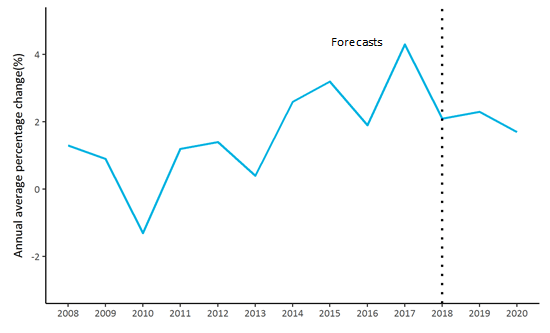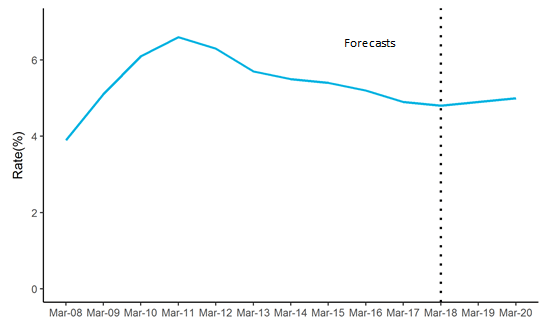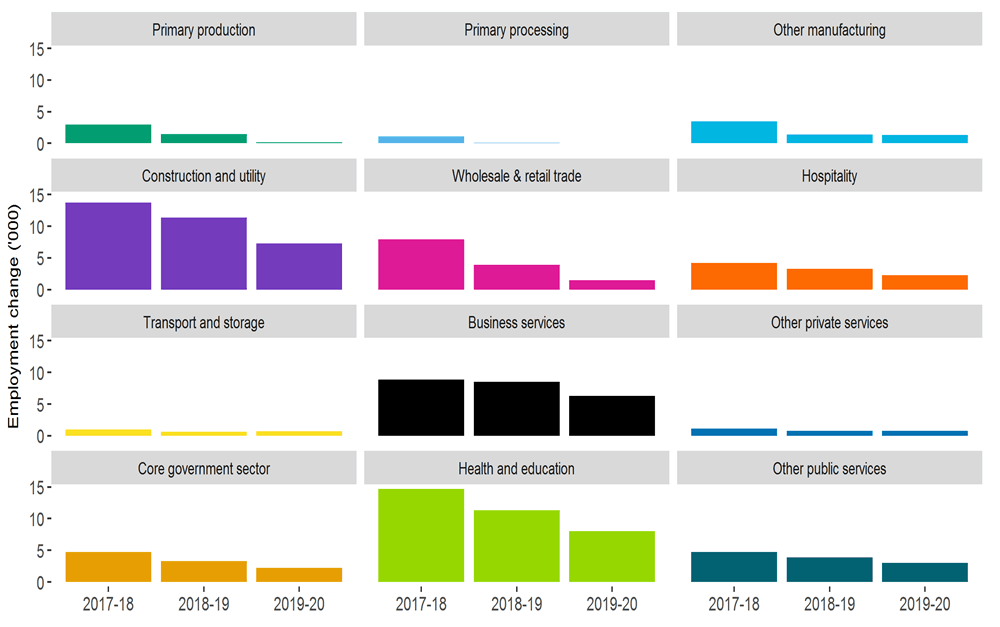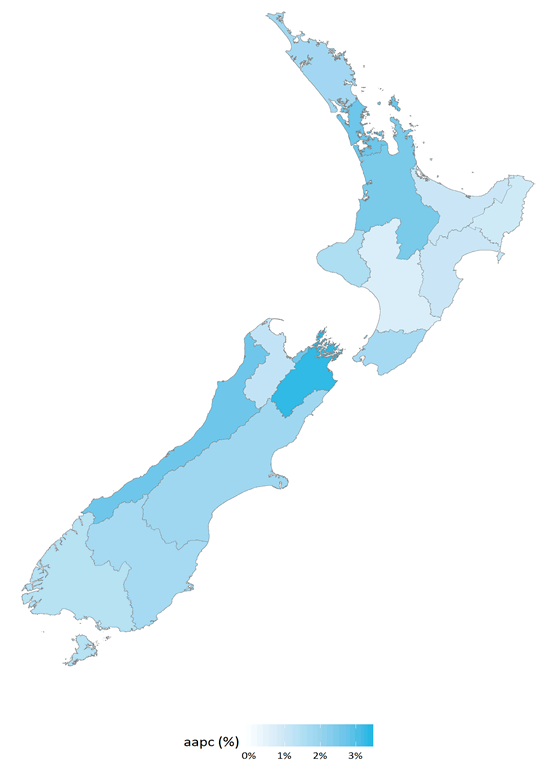Short-term employment forecasts 2017-2020 – May 2017
This May 2017 report presents employment forecasts for 2017 to 2020 (March years).
On this page
These short-term employment forecasts contribute to our advice relating to setting priorities for immigration, tertiary education and industry training over the next 2-3 years.
Short-term employment forecasts: 2017-2020 - May 2017 [PDF, 559 KB]
Region Employment Forecasts by Industries and Occupations - May 2017 [XLSX, 324 KB]
Key points
Over the next 3 years, employment demand will be strong in response to domestic focused growth: strong activity in the construction and business services sectors. Employment picks up to 2.8% in 2018 and then eases to 1.3% in 2020.
Over the next 3 years to 2020:
- Employment is forecast to grow by 152,000 between 2017 and 2020, but at different levels across the sectors and regions. This growth is supported by strong domestic demand over the forecast period.
- Unemployment rate is expected to remain at or below 5% over the forecast period, coinciding with labour demand growing faster than net migration driven strong labour supply growth.
- Construction and business services sectors will continue to boost employment over the next 2-3 years.
- Growth in demand for employment in highly skilled occupations (mostly managers and professionals) will be higher than the overall employment growth. Opportunities for lower-skilled workers are expected to account for nearly 30% of the employment growth over this period.
- Employment grows in all regions. North Island growth is highest in the Auckland, Waikato and Wellington regions and there is strong growth across the South Island.
National employment
Labour demand weakens as economic growth eases in 2020
The overall employment is forecast to grow by:
- 2.8% (or 68,600) in 2018
- 2.0% (or 50,000) in 2019
- 1.3% (or 33,400) in 2020.
This equates to 152,000 (or 2.0% on average) more people employed over the next 3 years.

Source: Statistics New Zealand, Household Labour Force Survey, MBIE
The data table for this figure can be found at the bottom of this page
Employment rising faster than labour supply growth will keep unemployment rate within 5%
The unemployment rate will remain at or below 5% over the forecast period. Even with labour supply easing due to slowing net migration levels over time, the unemployment rate is forecast to return to 5.0% by March 2020 quarter, when employment growth declines to 1.3%.
Figure 2. Unemployment rate

Source: Statistics New Zealand, Household Labour Force Survey, MBIE
The data table for this figure can be found at the bottom of this page
Table 1. Forecast labour market indicators (%), March quarters
|
Labour market indicators |
2017 |
2018 |
2019 |
2020 |
|
Employment rate |
67.1 |
67.3 |
67.2 |
67.3 |
|
Labour force participation |
70.6 |
70.7 |
70.7 |
70.8 |
|
Working-age population growth |
0.7 |
0.5 |
0.5 |
0.2 |
|
Unemployment rate |
4.9 |
4.8 |
4.9 |
5 |
Source: *Household Labour Force Survey, Statistics New Zealand; MBIE, Macro-labour market model
Industry
Construction and business services sectors continue to boost employment
Employment will increase in all broad sectors in the 3 years to 2020. The largest increases will be in the construction and utilities, business services, and health and education sectors. These sectors will have sizeable growth of over 20,000 by 2020, and will grow faster than the national average.
Figure 3. Employment changes by aggregated industries* – 2017 to 2020

Source: MBIE, Short-term employment model
The data table and extended data table for this figure can be found at the bottom of this page
Occupation
Demand will be strongest for highly skilled workers
Highly skilled occupations (mostly managers and professionals) will grow faster (2.9%) than overall employment growth (2.0%) on average between 2017 and 2020. We forecast the demand for skilled workers to increase by 2.1% per year on average over the next 3 years. By 2020, employment in skilled occupations will increase by 18,900 workers.
Table 2. Employment growth by skill level, March years
|
|
2017-18 |
2017-18 |
2018-19 |
2018-19 |
2019-20 |
2019-20 |
2017-20 |
2017-20 |
|
Skill-level (ANZSCO based) |
(000) |
(%) |
(000) |
(%) |
(000) |
(%) |
(000) |
(%) |
|
Highly skilled |
38.6 |
3.7 |
31.3 |
2.9 |
24.0 |
2.1 |
93.9 |
2.9 |
|
Skilled |
8.9 |
3.0 |
6.2 |
2.0 |
3.7 |
1.2 |
18.9 |
2.1 |
|
Semi-skilled |
14.9 |
2.1 |
9.0 |
1.2 |
4.6 |
0.6 |
28.5 |
1.3 |
|
Elementary skilled |
6.1 |
1.6 |
3.4 |
0.9 |
1.2 |
0.3 |
10.7 |
0.9 |
|
Total |
68.6 |
2.8 |
50.0 |
2.0 |
33.4 |
1.3 |
152.0 |
2.0 |
Source: MBIE, Short-term employment model and occupational/skill decomposition
*Employment forecasts data for 97 occupations can be found at the bottom of this page.
Regions
Employment grows in all regions — some rural regions to grow at a faster rate
At a regional level, the highest percentage employment growth will be in the Auckland and Waikato regions in the North Island, and Marlborough and Tasman regions in the South Island.
Overall, 5 out of the 16 regions (2 in the North Island and 3 in the South island) will grow faster than the national average of 2.0% per year over the forecast period.
Table 3. Employment growth by region, 3 years to 2020
|
Regional council |
2017-2020 |
2017-2020 |
|
|
(000) |
(AAPC*) |
|
Northland |
3.5 |
1.5% |
|
Auckland |
67.1 |
2.6% |
|
Waikato |
14.4 |
2.2% |
|
Bay of Plenty |
5.5 |
1.2% |
|
Gisborne |
0.6 |
0.8% |
|
Hawke's Bay |
2.7 |
1.0% |
|
Taranaki |
2.8 |
1.6% |
|
Manawatu-Wanganui |
3.9 |
1.1% |
|
Wellington |
14.5 |
1.7% |
|
Nelson |
1.0 |
1.1% |
|
Tasman |
2.3 |
3.3% |
|
Marlborough |
3.6 |
3.5% |
|
West Coast |
1.1 |
2.2% |
|
Canterbury |
19.5 |
1.9% |
|
Otago |
7.0 |
1.8% |
|
Southland |
2.5 |
1.5% |
|
Total |
152.0 |
2.0% |
Source: MBIE-Labour, short-term employment model and regional decomposition
*AAPC- annual average percentage change.
Detailed regional employment forecasts for 28 industries and 97 occupations [XLSX, 324 KB]
Figure 4: Annual average percentage change (aapc) by region, 2017- 2020

Source: MBIE, Short-term employment model and regional decomposition.
Data tables
Data table for Figure 1
Data table for Figure 2
Data table for Figure 3
Extended data table for Figure 3
Extended data table for Table 2

